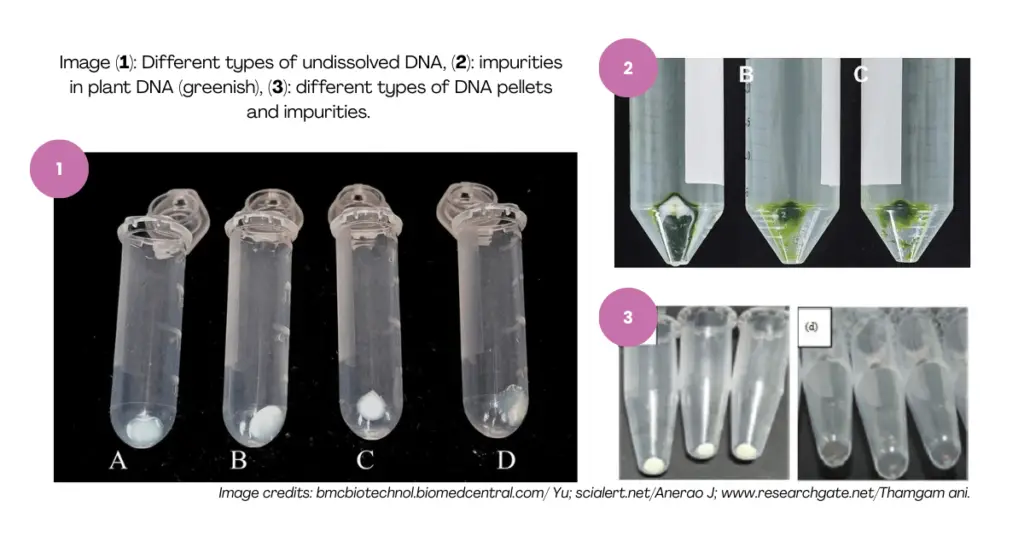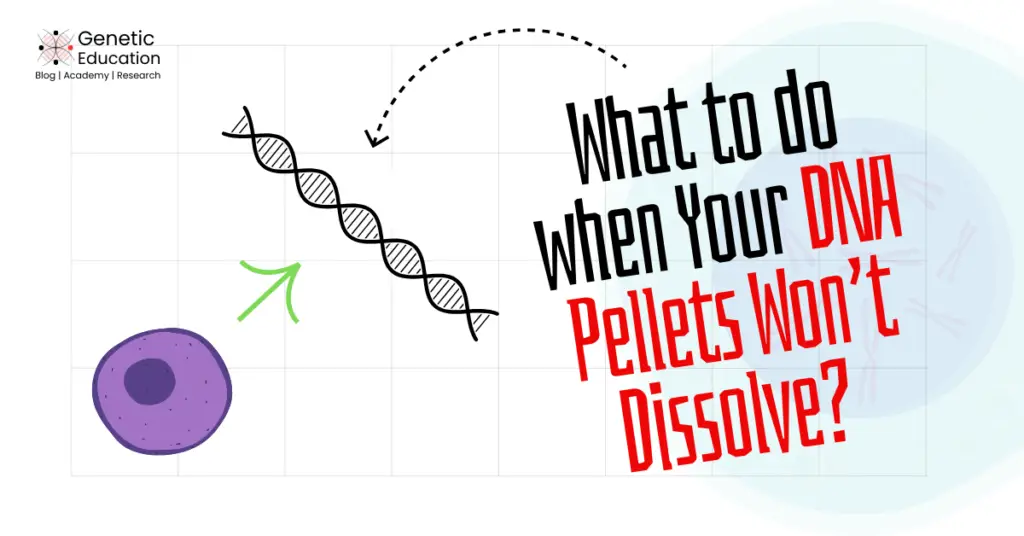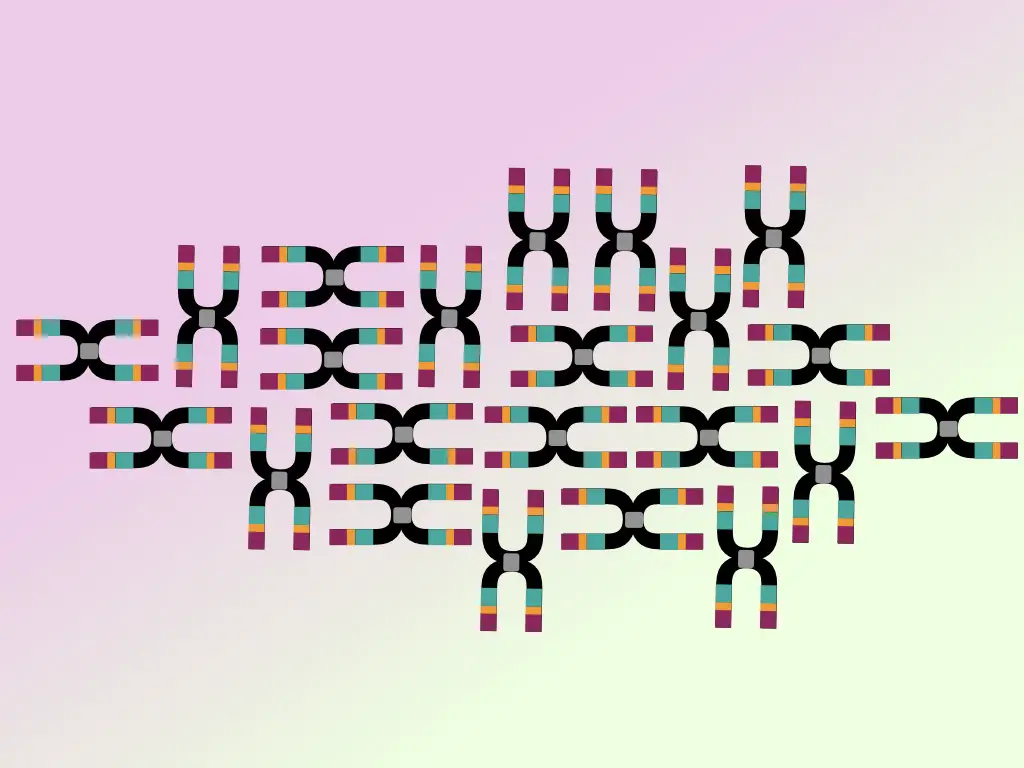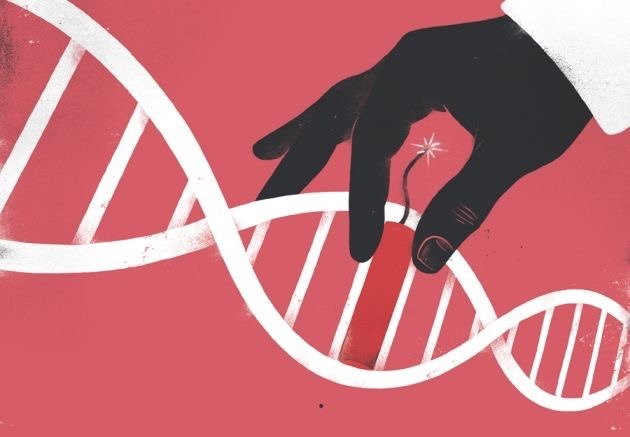“DNA won’t dissolve due to high DNA and salt conc, impurities, wrong elution buffer and over-drying. Explore how to fix it and improve your DNA extraction outcomes.”
DNA precipitation is an important step in manual DNA extraction. Once precipitates appear, peers believe that the work is complete! Adding a TE buffer will prepare DNA for use.
But what if your DNA can’t be dissolved in the TE buffer, or even in water?
DNA Extraction is instrumental for molecular genetic research. Manual DNA extraction methods have been widespread for students and college-level research. However, students have to face many challenges dealing with manual protocols.
One common challenge students often face is dissolving DNA after the completion of extraction. Inefficient DNA rehydration may create abnormalities in downstream analysis or even fail the experiment.
So it is crucial to properly dissolve the DNA.
In this manual DNA extraction guide, I will discuss why your DNA pellets won’t dissolve, what the possible reasons are, and how to overcome them.
Stay tuned.
Key Topics:
How to Dissolve the DNA?
The process of rehydrating the DNA pellets is referred to as dissolving the DNA or elution. The DNA is only usable during downstream application in rehydrated form.
To do so, a well-prepared TE buffer (pH 8.0) has been added to the DNA pellets, approximately 200- 300µL or as per the pellet yield. Nuclease-free water can also be used instead of TE buffer.
However, the Tris-EDTA buffer provides long-term DNA stability. You can read our complete guide on the TE buffer by clicking the link.
After adding the elution buffer, the tubes are inverted several times to dissolve the DNA in the buffer.
At a molecular level, the hydrated DNA pellets again react with the buffer or water molecule and dissolve in the solution.
It is important to avoid vortexing the genomic DNA as it fragments or breaks the DNA.
After several mixings, the pellets disappear, and DNA will form bonds with water or solution and completely dissolve.
Carefully analyze the rehydrated DNA solution. If any precipitate remains will be present in the tube or is visible, your DNA isn’t completely dissolved. Now, first, you need to understand why this happened!
Why won’t DNA pellets dissolve?
You need to rethink your experiment, what you have done so far, that help us find out the root cause.
Elution buffer- composition, pH or selection:
First, you need to recall whether you have chosen the right buffer or not. Tris-EDTA buffer is the first choice for excellent DNA elution. If you have a ready-to-use buffer, then it is fine; check the buffer pH once.
If the buffer is manually prepared, you need to re-investigate whether the buffer is correctly prepared or not.
The buffer should only contain Tris and EDTA in an adequate and/or required amount. Follow our previous article for the complete recipe.
The pH of the final TE buffer solution should be between 7.8 to 8.0. Too acidic or too basic solutions can reduce the solubility or degrade the DNA.
The final stock or working buffer solution should not have any type of visible impurities.
I strongly recommend using freshly prepared, hand-made TE buffers.
Note: Water sometimes can’t dissolve DNA efficiently due to pH ‘concen.’ If you use water, try using the TE buffer instead.
High DNA concentration:
The ultimate goal of any DNA extraction experiment is to obtain a high yield and quality DNA. However, higher DNA concentration isn’t always beneficial. You first need to understand how much buffer is needed for how much DNA!
However, no research explained any theory or calculation; it comes from experience and is also a matter of common sense.
If your DNA concentration is very high, and you have added a very low buffer volume, all the DNA molecules can’t be dissolved. The reason is that, at a molecular level, not sufficient solution or water molecules are available to occupy all the DNA.
The ideal buffer volume is 200- 300µL, but sometimes it isn’t sufficient! I will give you some data regarding the blood DNA extraction: volume required, yield, TE buffer required and applications according to the yield.
| Blood volume | Approximate DNA yield | TE buffer required | Suitable application |
| 0.2 mL | 1-2 µg | 20 µL | Low yield suitable for PCR |
| 0.5 mL | 5-10 µg | 30-50 µL | Good for basic molecular assays |
| 1.0 mL | 10-20 µg | 50-100 µL | Sufficient for multiple applications |
| 2.0 mL | 20-40 µg | 100-200 µL | Ideal for long-term storage and sequencing work |
Keep in mind, these data are prepared from my personal experience, many factors contribute to DNA yield. So what I am trying to say is that if we add 50 µL buffer to 40 µg DNA, then technically our DNA won’t be completely dissolved.
Got the point!
So what can you do? Review your protocol, how much starting material you used, for example, in case of a blood sample, if you used a 1 to 2 ml sample, start dissolving the DNA in 200 to 300 µL TE buffer.

Contaminants and impurities:
Impurities are the major culprit in why DNA won’t dissolve. Protein, phenol and other cellular and chemical impurities prevent DNA rehydration. Impurities are commonly observed in plant DNA extraction.
You can spot the greenish particles in the pellet mixture. This is because of the complex plant cellular structure. However, a similar type of reddish impurities can also be observed during blood DNA extraction.
Although other types of chemical and solution impurities are also significant. Here in the table, I have explained various types of impurities, their appearance and how they behave during elution.
| Impurity | Appearance | Indicator |
| Salt (e.g., Na+, acetate) | White or translucent crystalline material | Pellet feels gritty or crystalline; does not dissolve well; high 230 nm absorbance |
| Protein | Cloudy or slimy layer on or around the DNA pellet | Pellet may appear off-white or beige; poor A260/A280 ratio (~<1.8) |
| RNA | Transparent, jelly-like or mucous texture | Pellet appears slightly sticky or slippery; may cause viscosity |
| Phenol or organic solvent | Yellowish tint in pellet or supernatant | Often from phenol-based extraction; UV absorbance shows a peak at 270 nm |
| Ethanol (incomplete drying) | Pellet appears wet or shiny | DNA may dissolve poorly; it interferes with enzymatic reactions |
| Detergents (such as SDS) | Pellet appears slightly foamy or soft and sticky | Often from lysis buffer contamination, impacts purity |
| Hemoglobin/heme (from blood) | Red, brownish, or pink tint in the pellet | Poor separation during extraction from blood leads to low purity |
| Chlorophylls, polyphenols, polysaccharides and secondary metabolites | Greenish, jelly-like and viscous pellet | Complex plant cellular structure and poor DNA extraction protocol. |
Long story short, if you observe any type of abnormalities in DNA pellets, as explained in the table, your DNA extraction protocol is weak or not performed well.
Note that incomplete alcohol wash is also a common problem that leads to such impurities.
What you can do in such a situation is to adjust your DNA extraction protocol and improve the washing.
High salt concentration:
Salts play a significantly important role at various stages of DNA extraction. Salt, like sodium acetate, plays a crucial role during precipitation. However, if not removed completely, it prevents DNA from dissolving.
It has a tri-dimensional role here. Let’s do some chemistry and decode the technicality of why it interferes with dissolving the DNA.
The negative charge of the DNA interacts with the positive water ions, becomes more hydrophilic and rehydrates. The excess positive ions of salts, such as Na+ or K+, interact with the negative phosphate ions of the DNA, making it less hydrophilic and preventing it from dissolving.
Second, the salt forms crystals that appear gritty and hard and prevent DNA from complete rehydration.
Lastly, the salts also co-precipitate with the DNA and again form insoluble aggregates.
In conclusion, salt is also a major contributor to preventing DNA rehydration; however, it can be managed by adjusting the salt concentration simply by including a few washing steps.
Over-drying:
During the DNA extraction and after completion of the alcohol wash, we need to air dry our DNA pellets. Right? Now, the purpose here is to remove access to alcohol or any other solution that remains in the DNA.
Over-drying or heating interferes with the DNA elution.
Over-drying or heat drying makes the DNA structure harder, the tiny watery layer on the phosphate backbone is removed, which is needed to attract the water molecule during rehydration.
Due to the loss of the hydration DNA shell, its solubility decreases and interferes with the DNA rehydration process. In addition, the over-dried pellet can also stick to the tube wall, reducing the surface area for buffer and slowing down the resuspension process.
Pro-tip:
Don’t head DNA pellets directly, as it damages the DNA and the soluble DNA layer.
How to fix this?- Troubleshooting
Use a good-quality TE buffer. I strongly recommend preparing it by yourself, testing it and using it. You can read our previous guide to get the complete recipe for TE buffer.
Avoid using the nuclease-free water for DNA rehydration, if not mandatory.
Plan at least 3 alcohol washing steps, use a proper alcohol for washing, and read our previous guide to get insight on which alcohol to use for washing.
Guide: What is the Role of Alcohol in DNA Extraction?
Use an appropriate concentration of salt in the buffer and during precipitation. Use 1/10 volume of alcohol during precipitation. Use our complete guide to get more insight into this topic.
Guide: What is the Role of Sodium Acetate (NaAc) in DNA Extraction?
Avoid over-drying. Dry DNA pellets only at room temperature for 5 to 10 minutes or until the alcohol evaporates.
If already over-dried, warm the TE buffer at 37ºC, and apply to the DNA, try to mix it for 30 minutes, and then mix properly with gentle pipetting.
Note:
Rigorous pipetting can damage the DNA.
If any visible impurities appear, wash the DNA twice again. In case of a plant sample, the greenish impurities still appear (which may happen in most cases), use a spin column kit to further purify it.
Simply collect the DNA, apply it to the spin column tube and follow the spin-column DNA extraction protocol.
Incubate the sample (DNA pellets + buffer) at 50 to 60ºC for 5 to 10 minutes or until DNA dissolves completely. Avoid boiling.
Tap gently, or invert the tube several times to dissolve the DNA (this will work, trust me!).
If salt or impurities are suspected, re-precipitate the DNA and follow the washing steps again.
In case jelly-like DNA pellets appear, the DNA is contaminated with RNA, possibly, and should be re-precipitated, followed by RNase treatment.
Summary:
| Factor | Technical reason | Possible solution |
| High Salt Contamination | forms insoluble DNA complexes | Wash with 70% ethanol twice; air-dry completely |
| Over-Drying of Pellet | DNA becomes compact and hard | Add TE buffer, incubate at 37°C, gentle tapping |
| Residual Ethanol | interferes with solubility | Dry pellet for 5–10 min at room temperature |
| Low pH or Wrong Buffer | DNA is less soluble at acidic pH | Use TE buffer (pH 8.0), avoid acidic water |
| Protein/Phenol Contamination | Sticky complexes hinder hydration | Re-extract with phenol:chloroform or add proteinase K |
| High DNA concentration | Prevent complete rehydration | Add more TE buffer |
| Polysaccharides (Plant DNA) | Viscous matrix traps DNA | Use CTAB method, add NaCl and PVP |
| Chlorophyll/Polyphenols | Pigments bind DNA and reduce solubility | Add β-mercaptoethanol + PVP; extra chloroform extractions |
Pro-tip:
Try this exercise: Collect the DNA solution using a filter pipette tip. If the solution gets stuck or is difficult to pipette, it means the DNA is not fully rehydrated. A properly dissolved DNA solution should pipette as smoothly as water.
Don’t do this during the dissolving of the DNA:
- Don’t shake the tubes containing the DNA.
- Don’t pipette rigorously.
- Don’t vortex the sample hard.
- Avoid direct DNA heating or boiling.
- Avoid using any object or finger to crush or press the DNA.
Wrapping up:
Extracting a pure and high-yield DNA consistently, with manual DNA extraction protocols, is an art. If you can do that, you are an artist! Although manual DNA extraction methods are tedious to perform.
Students and PhD peers have to rely on these methods due to their tight budget. Nonetheless, by following the correct protocol and optimizing it as per their need, they can get good results.
To get more insight into various DNA extraction schemes and explore the protocols, keep visiting various articles on Genetic Education.
Do subscribe for more tips and protocols. Happy extraction!



Great insights on troubleshooting DNA dissolution issues! In my experience, ensuring the right buffer composition and avoiding over-drying are crucial. I’ve also found incubating the pellet at 37°C for a short time can help. Curious to hear if others have additional tips for tough samples!
Definitely, you are right!